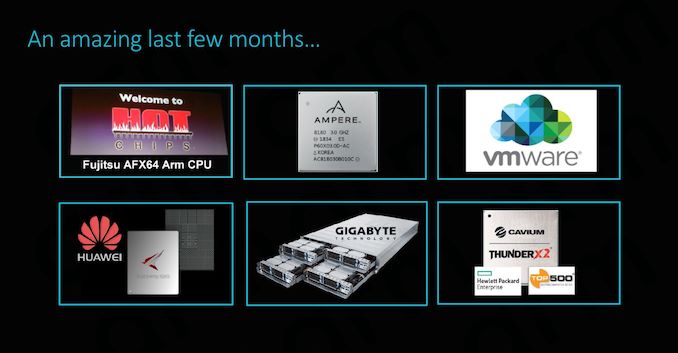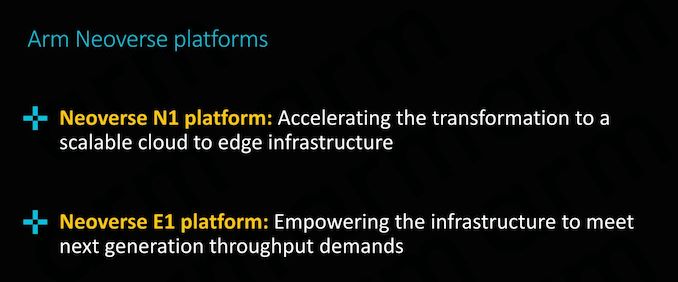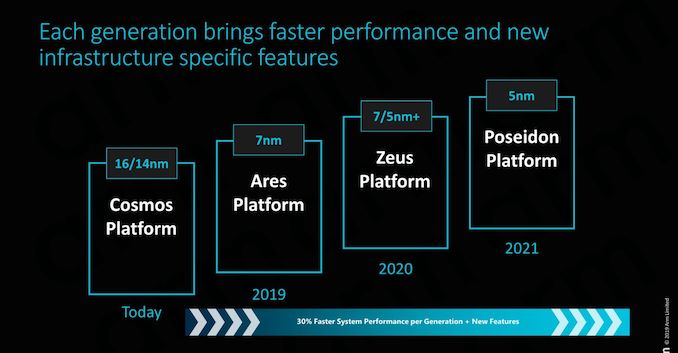Arm Announces Neoverse N1 & E1 Platforms & CPUs: Enabling A Huge Jump In Infrastructure Performance
by Andrei Frumusanu on February 20, 2019 9:00 AM EST
Anybody following the industry over the last decade will have heard of Arm. We best know the company for being the enabler and providing the architecture as well as CPU designs that power essentially all of today’s mobile devices. The last 7-5 years in particular we’ve seen meteoric advances in silicon performance of the mobile SoCs found in our smartphones and tablets.
However Arm's ambition goes widely beyond just mobile and embedded devices. The market for compute in general is a lot larger than that, and looking at things in a business sense, high-end devices like servers and related infrastructure carry far greater profit margins. So for a successful CPU designer like Arm who is still on the rise, it's a very lucrative market to aim for, as current leader Intel can profess.
To that end, while Arm has been wildly successful in mobile and embedded, anything requiring more performance has to date been out of reach or has come with significant drawbacks. Over the last decade we’ve heard of numerous prophecies how products based on the architecture will take the server and infrastructure market by storm “any moment now”. In the last couple of years in particular we’ve seen various vendors attempt to bring this goal to fruition: Unfortunately, the results of the first generation of products were less than successful, and as such, even though some did better than others, the Arm server ecosystem has seen a quite a bit of hardship in its first years.
A New Focus On Performance
While Arm has been successful in mobile for quite some time, the overall performance of their designs has often left something to be desired. As a result, the company has been undertaking a new focus on performance that is spanning everything from mobile to servers. Working towards this goal, 2018 was an important year for Arm as the company had introduced its brand-new Cortex A76 microarchitecture design: Representing a clean-sheet endeavor, learning from the experience gained in previous generations, the company has put high hopes in the brand-new Austin-family of microarchitectures. In fact, Arm is so confident on its upcoming designs that the company has publicly shared its client compute CPU roadmap through 2020 and proclaiming it will take Intel head on in PC laptop space.
While we’ll have to wait a bit longer for products such as the Snapdragon 8CX to come to market, we’ve already had our hands on the first mobile devices with the Cortex A76, and very much independently verified all of Arm’s performance and efficiency claims.
And then of course, there's Neoverse, the star of today's Arm announcements. With Neoverse Arm is looking to do for servers and infrastructure what it's already doing for its mobile business, by greatly ramping up their performance and improving their competitiveness with a new generation of processor designs. We'll get into Neoverse in much deeper detail in a moment, but in context, it's one piece of a much larger effort for Arm.
All of these new microarchitectures are important to Arm because they represent an inflection point in the market: Performance is now nearing that of the high-end players such as Intel and AMD, and Arm is confident in its ability to sustain significant annual improvements of 25-30% - vastly exceeding the rate at which the incumbent vendors are able to iterate.
The Server Inflection Point: An Eventful Last Few Months Indeed
The last couple of months have been quite exciting for the Arm server ecosystem. At last year’s Hotchips we’ve covered Fujitsu’s session of their brand-new A64FX HPC (High performance compute) processor, representing not only the company shift from SPARC to ARMv8, but also delivering the first chip to implement the new SVE (Scalable Vector Extensions) addition to the Arm architecture.
Cavium’s ThunderX2 saw some very impressive performance leaps, making its new processor among the first to be able to compete with Intel and AMD – with partners such as GIGABYTE offering whole server systems solutions based on the new SoC.
Most recently, we saw Huawei unveiled their new Kunspeng 920 server chip promising to be the industry’s highest performing Arm server CPU.
The big commonality between the above mentioned three products is the fact that each represents individual vendor’s efforts at implementing a custom microarchitecture based on an ARMv8 architectural license. This in fact begs the question: what are Arm’s own plans for the server and infrastructure market? Well for those following closely, today’s coverage of the new Neoverse line-up shouldn’t come as a complete surprise as the company had first announced the branding and road-map back in October.
Introducing the Neoverse N1 & E1 platforms: Enabling the Ecosystem
Today’s announcement is all about enabling the ecosystem; we’ll be covering in more detail two new “platforms” that will be at the core of Arm’s infrastructure strategy for the next few years, the Neoverse N1 and E1 platforms:
Particularly today’s announcement of the Neoverse N1 platform sheds light onto what Arm had teased back in the initial October release, detailing what exactly “Ares” is and how the server/infrastructure counter-part to the Cortex A76 µarchitecture will be bringing major performance boosts to the Arm infrastructure ecosystem.













101 Comments
View All Comments
surt - Thursday, February 21, 2019 - link
That raw power comes at a .... power cost. And as soon as you try to start z-stacking your cpus that power is going to be the most important factor.peevee - Tuesday, February 26, 2019 - link
"The future is way more related to modularity than the chip architecture."Debatable. Both ARM and x64 are essentially the same in terms of efficiency if the same levels of performance are required. A breakthrough can only come from in-memory computing, which neither ARM nor x64 can sustain for many reasons.
rahvin - Thursday, February 21, 2019 - link
ARM is not "more efficient at every level". That's just plain fanboi BS. The architecture is the least important aspect of any processor these days.ARM processors were traditionally designed for power efficiency above all else, now that Intel is designing down for efficiency and ARM is designing up for power there will likely be some real competition but so far ARM has not demonstrated that they can provide equivalent power for the same power budget at the high end and Intel has had difficulty matching the lower power budget and performance on the low end (though this is likely due to them wishing to avoid cannibalizing higher end products with performant low power versions).
As ARM tries to enter the server market we'll finally see if they can provide something equivalent, but it's not been a hopeful showing given that all but one ARM server design has been canceled and it's not equivalent to an x86 server processor of the same character in either power or performance.
Wilco1 - Thursday, February 21, 2019 - link
Today you can buy Arm-based servers like Operon A1100, Centriq, ThunderX, ThunderX2, eMAG and HiSilicon. The first Arm supercomputer entered the TOP500 list recently, and Fujitsu has prototypes of their Post-K computer. You can buy Arm compute time from several cloud vendors today, including AWS. That all adds up to one Arm server in your book?rahvin - Thursday, February 21, 2019 - link
ThunderX is gone, displaced by the ThunderX2 which is the Centriq processor after it was abandoned by it's creator. eMAG, A1100 and the HiSilicon Last I saw are all canceled.Commercially you can buy one ARM server, the ThunderX2. Go ahead, TRY to buy one.
Wilco1 - Thursday, February 21, 2019 - link
How could you be so clueless? ThunderX2 is based on Vulcan made by Broadcomm, no relation with Centriq at all. ThunderX is still being used and sold. Centriq is still being sold, a few months ago Gigabyte announced a brand new motherboard for it. eMAG is just announced. HiSilicon/Huawei has 2 generations of Arm servers already and is working on several more. That's the only one that isn't for sale outside of China according to AnandTech.What's next? Are you going to tell us that Arm servers did not beat Xeon and SkyLake in various benchmarks, eventhough the evidence was published in an article on AnandTech?
rahvin - Thursday, February 21, 2019 - link
Your right I confused the Vulcan and the Centriq. The Centriq is dead, the design teams gone,and there is no plan to even spin the silicon from what I've seen. Qualacom abandoned the product under threat from an activist investor. Yea there was a motherboard at CES but that doesn't mean anything at all and there is literally no way to buy one.ThunderX is depreciated (show me where you can buy one, they depreciated the silicon over a year ago, there may still be some inventory out there but I seriously doubt it), ThunderX2 is available, and from everything I saw it's awful. The best work case was as a nginx master server because the compute capacity was so awful. Basically you need a workload with a lot of threads and no actual work to even make it worth anything at all, especially considering the price.
The Huawei junk is a nonstarter, you can't buy it anywhere but China that I've seen and it's not exactly flying off the shelves either. I've seen more ARM servers announced and canceled a year later than any that made it off the shelves into an actual product. So there is an eMag, that's great show me where you can buy it.
That's my point, you can't buy them, other than the ThunderX2 or the Huawei if you want to go to china to get it. The Arm server has been a flash in the pan and I have no doubt it will continue to be so.
FunBunny2 - Wednesday, February 20, 2019 - link
one has to wonder: given the existence of C compilers for any ISA, and thus *nix OS for said ISA, when (or already?) will the maths dictate both the 'optimal' ISA and underlying microarch? both, after all, are just maths optimization problems. to some delta, there is a unique solution.zmatt - Wednesday, February 20, 2019 - link
Baring any major design flaws there shouldn't really be a difference in theoretical performance between ISAs. Its important to note that the ISA isn't the actual logic of the chip, its better thought of as a paper standard a given chip needs to conform to if it wants to be binary compatible. The real determination in performance is the microarchitecture. People conflate this with ISA a lot because they are both architectures but the Micro arch is what describes the actual logic design in the circuit. That is what Intel and AMD apply codenames to. So things like Skylake, Thunderbird, Cortex A53 etc are micro architectures.Wilco1 - Wednesday, February 20, 2019 - link
There certainly are differences between ISAs which cannot be overcome with micro-architecture no matter how much money, power or transistors you throw at it. Given equal resources, the best possible implementations of various ISAs will exhibit major performance differences.